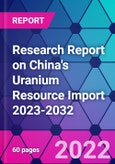In 2021, China's imports of uranium resources reached 13,613.9 tons, down 18.4% year-on-year, and the import value of US$1.31 billion, down 22.6% year-on-year. In the first three quarters of 2022, China imported 9,351.5 tons of uranium, up 5.2% year-on-year, and US$1.36 billion in imports, up 48.5% year-on-year, according to the publisher's analysis.
The average import price of uranium is volatile in 2018-2022. In 2019, the average import price of uranium resources in China is US$125.2 per kg, an increase of 38.3% year-on-year. According to the publisher's analysis, the average import price of uranium decreases continuously from 2019 to 2021, with the average import price of uranium decreasing to US$96.5 per kg in 2021. In the first three quarters of 2022, the average import price of uranium increases significantly to US$145.6 per kg, an increase of 41.1% compared to the same period in 2021.
China imports uranium resources mainly in two categories: natural uranium and U235 enriched uranium. In 2021, China imported 13,535.8 tons of natural uranium, accounting for 99.4% of total imports, and the import value of US$1.21 billion, accounting for 92.4% of total imports. In 2021, China imported natural uranium resources from five countries and regions. According to the publisher's analysis, Kazakhstan is the largest source of natural uranium imports to China by import volume. In 2021, China imported 6,459.1 tons of natural uranium from Kazakhstan, accounting for 47.7% of total natural uranium imports, and US$550 million, or 45.6% of total natural uranium imports.
China lacks indigenous uranium resources and is highly dependent on imports. China's nuclear power generation accounts for approximately 5% of the country's total power generation, leaving much room for improvement, and The publisher expects that China's uranium imports are expected to continue to rise from 2023-2032 as the country's installed nuclear power generation rises further and demand for uranium resources continues to grow.
Topics covered:
- China's Uranium Resource Import Status and Major Sources in 2018-2022
- What is the Impact of COVID-19 on China's Uranium Resource Import?
- Which Companies are the Major Players in China's Uranium Resource Import Market and What are their Competitive Benchmarks?
- Key Drivers and Market Opportunities in China's Uranium Resource Import
- What are the Key Drivers, Challenges, and Opportunities for China's Uranium Resource Import during 2023-2032?
- What is the Expected Revenue of China's Uranium Resource Import during 2023-2032?
- What are the Strategies Adopted by the Key Players in the Market to Increase Their Market Share in the Industry?
- What are the Competitive Advantages of the Major Players in China's Uranium Resource Import Market?
- Which Segment of China's Uranium Resource Import is Expected to Dominate the Market in 2032?
- What are the Major Adverse Factors Facing China's Uranium Resource Import?
Table of Contents
Methodology
Background research defines the range of products and industries, which proposes the key points of the research. Proper classification will help clients understand the industry and products in the report.
Secondhand material research is a necessary way to push the project into fast progress. The analyst always chooses the data source carefully. Most secondhand data they quote is sourced from an authority in a specific industry or public data source from governments, industrial associations, etc. For some new or niche fields, they also "double-check" data sources and logics before they show them to clients.
Primary research is the key to solve questions, which largely influence the research outputs. The analyst may use methods like mathematics, logical reasoning, scenario thinking, to confirm key data and make the data credible.
The data model is an important analysis method. Calculating through data models with different factors weights can guarantee the outputs objective.
The analyst optimizes the following methods and steps in executing research projects and also forms many special information gathering and processing methods.
1. Analyze the life cycle of the industry to understand the development phase and space.
2. Grasp the key indexes evaluating the market to position clients in the market and formulate development plans
3. Economic, political, social and cultural factors
4. Competitors like a mirror that reflects the overall market and also market differences.
5. Inside and outside the industry, upstream and downstream of the industry chain, show inner competitions
6. Proper estimation of the future is good guidance for strategic planning.

LOADING...








